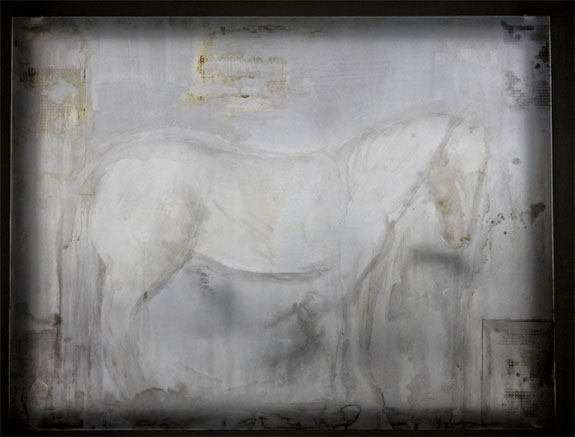 |
.jpg) |
Two pieces in this show, both from Campbell’s Home Movies series, demonstrate. One is titled Home Movie (Grid); the other is called Home Movies Pause. Both employ footage Campbell purchased on eBay. In the first, unreadable black-and-white shadows play across a grid. Back up 50 feet and previously illegible subjects — children skating, swimming, diving and riding a carousel — come into “view.” I place the word view in quotes because their faces are little more than ghostly outlines scrubbed of identifying detail. Yet for all the anonymity projected, it’s impossible not to
project yourself into these pictures. Through what psychological or neural mechanism this happens I can’t say. What I can tell you is that the absence of details goads the mind into creating them, a transaction that spurs an eerie superimposition of strangers’ experiences onto our own.
.jpg) |
Two pieces that were highlights of Campbell’s 2014 show at Hosfelt Gallery also appear here. Again, they’re knockouts for the same reasons I cited earlier. So I quote from what I wrote in that review: “In Light Topography (Jane’s Pool), Campbell achieves an almost preternatural level of clarity by mounting single LEDs on the tips of variable-length dowels. Set perpendicular to the wall, they wink off and on like electronic fireflies, moving in a pointillist swarm to form a negative image of a woman swimming across deep space. Less dramatic, but no less riveting is Topography Reconstruction (Wave). It measures a scant 18 x 23 x 4 inches, and consists of a resin-cast seascape laid atop a film projection of breaking surf. It emits a dull, gray-white light whose flickering, shadowy contours come closer to re-creating the quality of the wave-watching experience than any work of art I’ve seen.” This is an exceptionally difficult task given the challenge of enacting or evoking a phenomenon that is all about motion, repetition and endless variation. Campbell, by creating a physical topography for his images of waves to play against, gives us a work of art that “does everything but emit bird cries and the briny smell of salt air.”
 |